Kia Rio: Cylinder Block / Piston and Connecting Rod
Repair procedures
| • |
Use fender covers to avoid damaging painted surfaces.
|
| • |
To avoid damaging the cylinder head, wait until the engine coolant
temperature drops below normal temperature before removing it.
|
| • |
When handling a metal gasket, take care not to fold the gasket
or damage the contact surface of the gasket.
|
| • |
To avoid damage, unplug the wiring connectors carefully while
holding the connector portion.
|
|
| • |
Mark all wiring and hoses to avoid misconnection.
|
| • |
Turn the crankshaft pulley so that the No.1 piston is at TDC
(Top dead center).
|
|
| 1. |
Remove the engine assembly from the vehicle.
(Refer to Engine and Transaxle Assembly - "Engine and Transaxle Assembly”)
|
| 2. |
Remove the transaxle assembly from the engine assembly.
·Manual Transaxle
(Refer to Manual Transaxle System - "Manual Transaxle")
·Automatic Transaxle
(Refer to Automatic Transaxle System - "Automatic Transaxle")
|
| 3. |
Remove the drive plate or flywheel.
·Automatic Transaxle
(Refer to Cylinder Block Assembly - "Drive Plate")
·Manual Transaxle
(Refer to Cylinder Block Assembly - "Flywheel")
|
| 4. |
Install the engine to engine stand for disassembly.
|
| 5. |
Remove the timing chain.
(Refer to Timing System - "Timing Chain”)
|
| 6. |
Remove the intake manifold.
(Refer to Intake and Exhaust System - "Intake Manifold")
|
| 7. |
Remove the exhaust manifold.
(Refer to Intake and Exhaust System - "Exhaust Manifold")
|
| 8. |
Remove the cylinder head assembly.
(Refer to Cylinder Head Assembly - "Cylinder Head")
|
| 9. |
Remove the water pipe.
(Refer to Cooling System - "Thermostat")
|
| 10. |
Remove the water temperature control assembly.
(Refer to Cooling System - "Thermostat")
|
| 11. |
Remove the oil pan and oil screen.
(Refer to Lubrication System - "Oil Pan")
|
| 12. |
Remove the ladder frame.
(Refer to Cylinder Block - "Cylinder Block")
|
| 13. |
Check the connecting rod end play.
|
| 14. |
Remove the connecting rod caps and check oil clearance.
|
| 15. |
Check the connecting rod cap oil clearance.
|
| 16. |
Remove the piston and connecting rod assemblies.
| (1) |
Using a ridge reamer, remove all the carbon from the top of the
cylinder.
|
| (2) |
Remove the connecting rod cap (A).
|
| (3) |
Push the piston, connecting rod assembly (B) and upper bearing
through the top of the cylinder block.
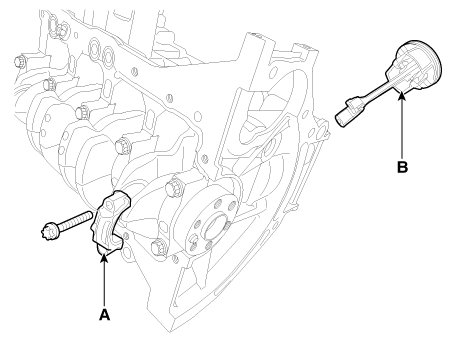
|
• |
Keep the bearings, connecting rod and cap together.
|
|
• |
Arrange the piston and connecting rod assemblies
in the correct order.
|
|
|
|
| 17. |
Check fit between piston and piston pin.
Try to move the piston back and forth on the piston pin. If any movement
is felt, replace piston and piston pin as a set.
|
| 18. |
Remove the piston rings.
| (1) |
Using a piston ring expander, remove the 2 compression rings.
|
| (2) |
Remove 2 side rails and the spacer by hand.
|
Arrange the piston rings in the correct order only.
|
|
|
| 19. |
Remove the connecting rod from the piston.
Using a press, remove the piston pin from the piston.
|
Press-in load : 150 - 750 kg (331 - 1653 lb)
|
|
Connecting Rod
| 1. |
Check the connecting rod end play.
Using a feeler gauge, measure the end play while moving the connecting
rod back and forth.
|
Standard end play :
0.10 - 0.25 mm (0.0039 - 0.0098 in)
|
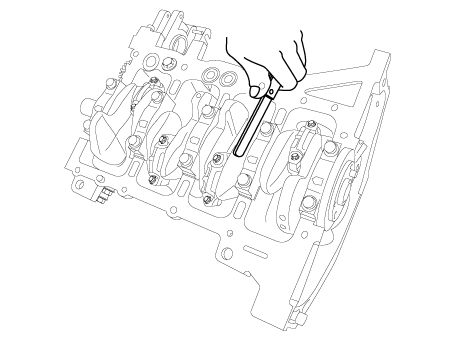
| (1) |
If out-of-tolerance, install a new connecting rod.
|
| (2) |
If still out-of-tolerance, replace the crankshaft.
|
|
| 2. |
Check the connecting rod bearing oil clearance.
| (1) |
Check the match marks on the connecting rod and cap are aligned
to ensure correct reassembly.
|
| (2) |
Remove the 2 connecting rod cap bolts.
|
| (3) |
Remove the connecting rod cap and lower bearing.
|
| (4) |
Clean the crank pin journal and bearing.
|
| (5) |
Place a plastigage across the crankshaft pin journal.
|
| (6) |
Reinstall the lower bearing and cap, and tighten the bolts.
|
Tightening torque :
11 - 15 N·m (1.1 - 1.5 kgf·m, 8.0 - 10.8 lb·ft) + 88
- 92°
|

|
• |
Do not turn the crankshaft.
|
|
• |
Always use new connecting rod cap bolts. Connecting
rod cap bolts are torque-to-yield bolts designed
to be permanently elongated beyond the state of
elasticity when torqued, so if the bolts are removed
and reused, it may cause the bolts to break or fail
to maintain clamping force.
|
|
|
| (7) |
Remove the 2 bolts, connecting rod cap and lower bearing.
|
| (8) |
Measure the plastigage at its widest point.
|
Connecting rod bearing oil clearance :
0.018 - 0.036 mm (0.0007 - 0.0014 in)
Connecting rod bearing oil clearance Include big hole
expansion deformation :
0.027 - 0.052 mm (0.0011 - 0.0020 in)
|
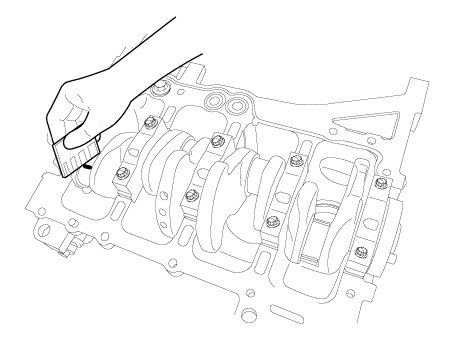
|
| (9) |
If the plastigage measures too wide or too narrow, remove the
upper and lower bearing and then install a new bearings with the
same color mark (Refer to connecting rod bearing selection table)
Recheck the oil clearance.
|
Do not file, shim, or scrape the bearings or the caps
to adjust clearance.
|
|
| (10) |
If the plastigage shows the clearance is still incorrect, try
the next lager or smaller bearing. (Refer to connecting rod bearing
selection table Recheck the oil clearance.
|
If the proper clearance cannot be obtained by using the
appropriate lager or smaller bearings, replace the crankshaft
and start over.
|
|
If the alignment marks are unreadable because of an accumulation
of grease or grime, don't clean with a wire or abrasive
cleaner. Clean only with correct cleaning solvent or detergent.
|
Connecting Rod Mark Location
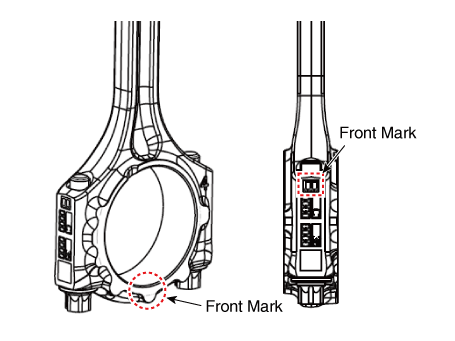
Discrimination Of Connecting Rod
Grade
|
Mark
|
Connecting Rod Big-end Inner Diameter
|
0
|
A
|
42.000 - 42.006 mm
(1.6535 - 1.6540 in)
|
1
|
B
|
42.006 - 42.012 mm
(1.6537 - 1.6540 in)
|
2
|
C
|
42.012 - 42.018 mm
(1.6540 - 1.6542 in)
|
Crankshaft Pin Journal Mark Location
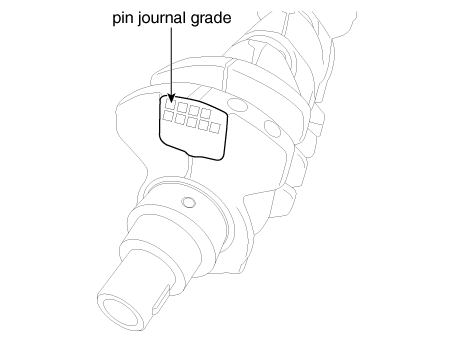
Discrimination Of Crankshaft Pin Journal
Class
|
Mark
|
Crankshaft Pin Journal outer Diameter
|
I
|
1
|
38.966 - 38.972 mm
(1.5340 - 1.5343 in)
|
II
|
2
|
38.960 - 38.966 mm
(1.5338 - 1.5340 in)
|
III
|
3
|
38.954 - 38.960 mm
(1.7698 - 1.7701 in)
|
Connecting Rod Bearing Mark Location
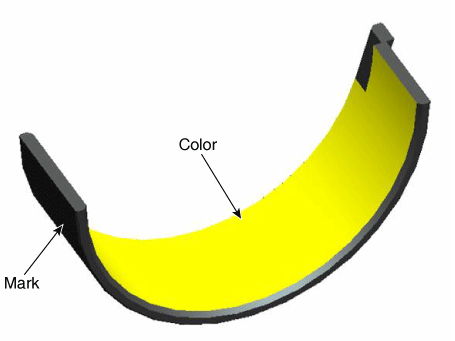
Discrimination Of Connecting Rod Bearing
Grade
|
Color
|
Connecting Rod Bearing Thickness
|
A
|
Blue
|
1.514 - 1.517 mm
(0.0596 - 0.0597 in)
|
B
|
Black
|
1.511 - 1.514 mm
(0.0595 - 0.0596 in)
|
C
|
None
|
1.508 - 1.511 mm
(0.0594 - 0.0595 in)
|
D
|
Green
|
1.505 - 1.508 mm
(0.0593 - 0.0594 in)
|
E
|
Yellow
|
1.502 - 1.505 mm
(0.0591 - 0.0593 in)
|
|
| (11) |
Select the bearing by using selection table.
Connecting Rod Bearing Selection Table
Connecting Rod Bearing
|
Connecting Rod Mark
|
0(A)
|
1(B)
|
2(C)
|
Crank shaft pin journal mark
|
I(1)
|
E(Yellow)
|
D(Green)
|
C(None)
|
II(2)
|
D(Green)
|
C(None)
|
B(Black)
|
III(3)
|
C(None)
|
B(Black)
|
A(Blue)
|
|
|
Piston
| 1. |
Clean the piston
| (1) |
Using a gasket scraper, remove the carbon from the piston top.
|
| (2) |
Using a groove cleaning tool, clean the piston ring grooves.
|
| (3) |
Using solvent and a brush, thoroughly clean the piston.
|
|
| 2. |
The standard measurement of the piston outside diameter is taken 30.0mm
(1.21in) from top land of the piston.
|
Standard diameter :
71.970 - 72.000 mm (2.8334 - 2.8346 in)
|
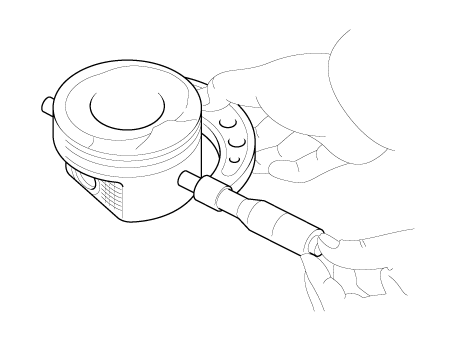
|
| 3. |
Check the cylinder bore size code on the cylinder block.
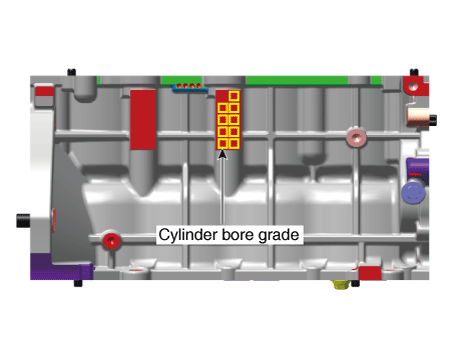
Discrimination of cylinder bore size
Grade
|
Size code
|
Cylinder Bore inner Diameter
|
a
|
A
|
72.00 - 72.01 mm
(2.8346 - 2.8350 in)
|
b
|
B
|
72.01 - 72.02 mm
(2.8350 - 2.8354 in)
|
c
|
C
|
72.02 - 72.03 mm
(2.8354 - 2.8358 in)
|
|
| 4. |
Check the piston size code (A) and the front mark (B) on the piston top
face.
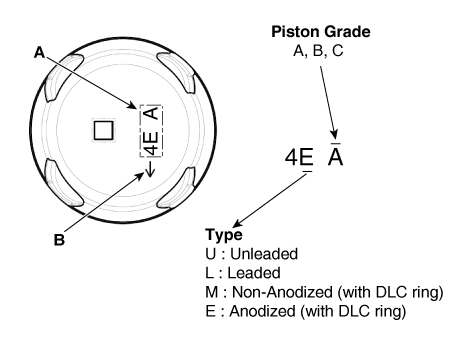
Discrimination Of Piston Outer Diameter
Grade
|
Size code
|
Piston Outer Diameter
|
a
|
A
|
71.970 - 71.980 mm
(2.8334 - 2.8338 in)
|
b
|
B
|
71.980 - 71.990 mm
(2.8338 - 2.8342 in)
|
c
|
C
|
71.990 - 72.000 mm
(2.8342 - 2.8346 in)
|
|
| 5. |
Select the piston related to cylinder bore class.
|
Clearance :
0.02 - 0.04 mm (0.0008 - 0.0016 in)
|
|
Piston Rings
| 1. |
Calculate the difference between the cylinder bore diameter and the piston
diameter.
|
Piston-to-cylinder clearance :
0.02 - 0.04mm (0.0008 - 0.0016in)
|
|
| 2. |
Inspect the piston ring side clearance.
Using a feeler gauge, measure the clearance between new piston ring and
the wall of the ring groove.
|
Piston ring groove width
No.1 : 1.035 - 1.05 mm (0.0407 - 0.0413 in)
No.2 : 1.23 - 1.25 mm (0.0484 - 0.0492 in)
Oil ring : 1.995 - 2.010 mm (0.0785 - 0.0791 in)
Piston ring width
No.1 : 0.97- 0.985 mm (0.0381 - 0.0387 in)
No.2 : 1.17 - 1.19 mm (0.0460 - 0.0468 in)
Oil ring : 1.925 - 1.955 mm (0.0758 - 0.0770 in)
Piston ring side clearance
No.1 : 0.05 - 0.08 mm (0.0019 - 0.0031 in)
No.2 : 0.04 - 0.08 mm (0.0015 - 0.0031 in)
Oil ring : 0.040 - 0.850 mm (0.0015 - 0.0335 in)
|
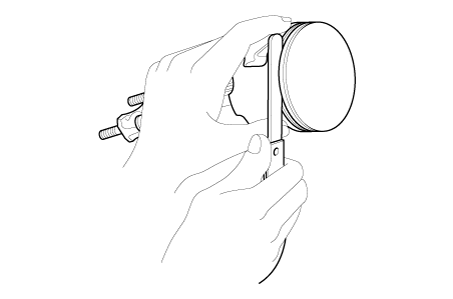
If the clearance is greater than maximum, replace the piston.
|
| 3. |
Inspect piston ring end gap.
To measure the piston ring end gap, insert a piston ring into the cylinder
bore. Position the ring at right angles to the cylinder wall by gently pressing
it down with a piston. Measure the gap with a feeler gauge. If the gap exceeds
the service limit, replace the piston ring. If the gap is too large, recheck
the cylinder bore diameter against the wear limits. If the bore is over
the service limit, the cylinder block must be replaced.
|
Piston ring end gap
No.1 : 0.13 - 0.18 mm (0.0051 - 0.0335 in)
No.2 : 0.25 - 0.40 mm (0.0098 - 0.0157 in)
Oil ring : 0.10 - 0.40 mm (0.0039 - 0.0157 in)
|
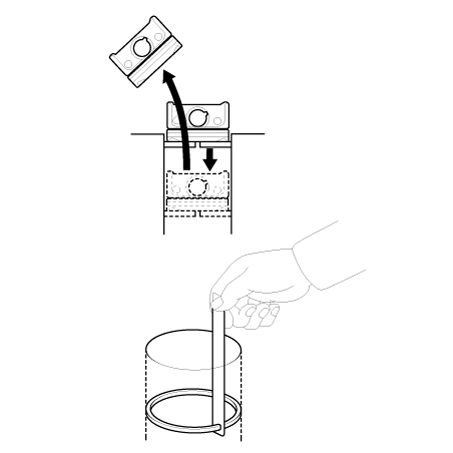
|
Piston Pins
| 1. |
Measure the diameter of the piston pin.
|
Piston pin outer diameter :
18.000 - 18.003 mm (0.7086 - 0.7087 in)
Piston pin hole diameter :
18.013 - 18.017 mm (0.7092 - 0.7093 in)
Connecting rod small end inner diameter :
17.974 - 17.985 mm (0.7076 - 0.7080 in)
|

|
| 2. |
Measure the piston pin-to-piston clearance.
|
Piston pin-to-piston clearance :
0.010 - 0.017 mm (0.00039 - 0.00067 in)
|
|
| 3. |
Check the difference between the piston pin outer diameter and the connecting
rod small end inner diameter.
|
Piston pin-to-connecting rod interference :
0.015 - 0.029 mm (0.0006 - 0.0014 in)
|
|
| • |
Thoroughly clean all parts to be assembled.
|
| • |
Before installing the parts, apply fresh engine oil to all sliding
and rotating surfaces.
|
| • |
Replace all gaskets, O-rings and oil seals with new parts.
|
|
| 1. |
Assemble the piston and connecting rod.
| (1) |
Use a hydraulic press for installation.
|
| (2) |
The piston front mark and the connecting rod front mark must
face the timing belt side of the engine.

|
|
| 2. |
Install the piston rings.
| (1) |
Install the oil ring expender and 2 side rails by hand.
|
| (2) |
Using a piston ring expender, install the 2 compression rings
with the code mark facing upward.
|
| (3) |
Position the piston rings so that the ring ends are as shown.
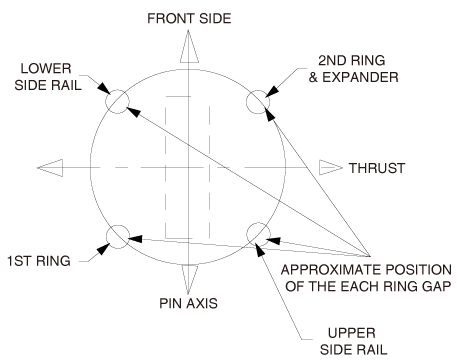
|
|
| 3. |
Install the connecting rod bearings.
| (1) |
Align the bearing claw with the groove of the connecting rod
and connecting rod cap.
|
| (2) |
Install the bearings (A) in the connecting rod and connecting
rod cap (B).

|
|
| 4. |
Install the piston and connecting rod assemblies.
| •
|
Before installing the pistons, apply a coat of engine
oil to the ring grooves and cylinder bores.
|
| •
|
The piston front mark (A) and the connecting rod front
mark (B) must face the timing chain side of the engine.
|
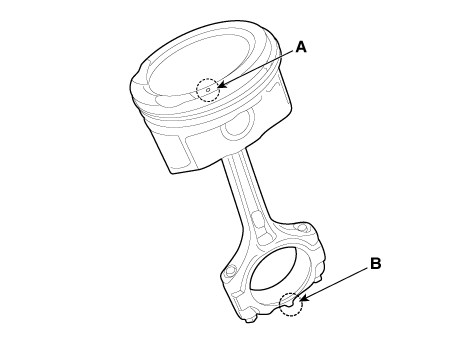
|
| (1) |
Install the ring compressor, check that the bearing is securely
in place, then position the piston in the cylinder, and tap it in
using the wooden handle of a hammer.
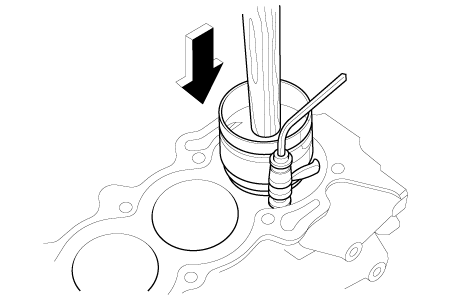
|
| (2) |
Stop after the ring compressor pops free, and check the connecting
rod to check journal alignment before pushing the piston into place.
|
| (3) |
Apply engine oil to the bolt threads. Install the rod caps with
bearings, and tighten the bolts.
|
Tightening torque :
11 - 15 N·m (1.1 - 1.5 kgf·m, 8.0 - 10.8 lb·ft) + 88
- 92°
|

|
• |
Always use new connecting rod cap bolts. Connecting
rod cap bolts are torque-to-yield bolts designed
to be permanently elongated beyond the state of
elasticity when torqued, so if the bolts are removed
and reused, it may cause the bolts to break or fail
to maintain clamping force.
|
|
• |
Maintain downward force on the ring compressor
to prevent the rings from expending before entering
the cylinder bore.
|
|
|
|
| 5. |
Check the connecting rod end play.
|
| 6. |
Assemble the other parts in the reverse order of disassembly.
|
Repair procedures
Replacement
1.
Remove the transaxle assembly.
(Refer to Manual Transaxle System - "Manual Transaxle")
(Refer to Automatic Transaxle Syste ...
Repair procedures
Disassembly
•
Use fender covers to avoid damaging painted surfaces.
...
Other information:
Components and components location
Components
1. Shift lever knob & boots
2. Shift lever assembly
3. Shift cable assembly
Repair procedures
Removal
1.
Shift the gear to "N".
2.
...
Repair procedures
Inspection
Engine Oil Level
Be sure that the vehicle is on level ground.
1.
Warm up and stop the engine, and then wait for 5 minutes.
2.
Turn the ...
 Rear Oil Seal
Rear Oil Seal Crankshaft
Crankshaft



















